It’s a new camera by Sony with 8-55mm w/lens hood or 16mm lens,Flash,Body cap,Lens caps,Lithium-ion battery,Battery charger,USB cable,Shoulder strap and many more….

Sony’s NEX-5 is the first of two new hybrid camera models from Sony, offering a large-size APS HD CMOS sensor capable of 1080i HD movie capture and high quality images to the heady heights of ISO 12,800. Will it revolutionise the hybrid camera market?
The hybrid camera market continues to hot up, with Sony the latest manufacturer to dip its wick into this market. Its first offering is the NEX-5 (joint released with the mightily similar, slightly lower spec NEX-3), a compact-like hybrid model that is the first to showcase the company’s new 14.2-megapixel APS HD CMOS sensor which includes the SteadyShot INSIDE sensor-based image stabilisation system.
The promise of mirrorless digital cameras has been high image quality without all the bulk, and the photographic versatility of interchangeable lenses. The Sony NEX-5 delivers that better than any model so far, and does it with style and a sturdy build.
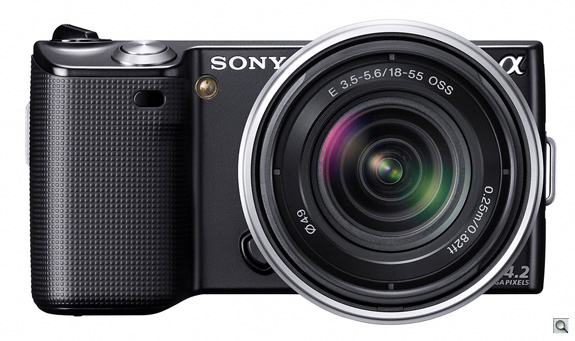
Whether the balance of body size to sensor size is sensible is for debate, yet one thing is clear – Sony hasn’t followed the DSLR-like designs that all the other hybrid manufacturers continue to push (like Samsung’s NX10 or the Panasonic Lumix G2), so the NEX looks to offer a different approach. In use this certainly rings true, the feel is very much like a compact that is rapidly responsive – its Quick AF Live View system provides fast and accurate autofocus that is as good as the next best offering out there and leaves your average compact camera in the dust.
The only real qualm when shooting is just how “tucked away” all the options are. Point and shoot is a breeze, but go to change options – such as the ISO setting – and a variety of button presses and menu scrolls later will eventually reveal what you’re after. It can become a frustration as there are no user-assignable buttons to make quick-access to those key settings and when first turning the camera on it takes over a second before its ready for use (compared to the competition that’s too slow for rapid use).
A 14-megapixel Exmor APS HD CMOS sensor is responsible for the high quality we found in the images from both cameras, and a new Bionz processor is also hard at work in the two cameras.
Several hot features were brought over from recent Alphas and Cyber-shot digital cameras, including Sweep Panorama, Auto High-Dynamic Range shooting, Handheld Twilight, and Anti-motion-blur modes, each of which strategically combine and align several images into one seamless one. It’s pretty impressive stuff. As if that weren’t enough, Sony’s also announcing an upcoming upgrade.
Though by name the new cameras are Alphas, they no longer use the Alpha mount; instead Sony has christened a new E-mount, for which two lenses will ship right away, both as kit lenses. The first is a fairly standard 18-55mm f/3.5-6.3 lens with Optical SteadyShot, and the second is a 16mm f/2.8 pancake prime lens. Both have a beautiful aluminum barrel in brushed gunmetal gray.
Adjusting for exposure compensation and burst mode – which can shoot up to a super-fast 7 frames per second – is fine as these are fixed on the d-pad found on the rear, but a standard command dial lacks from the top and the three main buttons to the rear only allow for menu access and entry into the Help Guide.

Unlike the rest of the SLD (single-lens, direct-view) digital cameras, the two new Sony NEX-series cameras don’t try at all to look like an SLR or rangefinder. Instead they look more like a midsize digital camera with a big lens grafted on. Bordering on the absurd, especially with the 18-55mm lens mounted, the Sony NEX-5 manages to pull off this seeming overemphasis on optics if only because of the lens’s shiny aluminum barrel, whose efficient shape speaks of precision. After several years of relative sameness among digital camera designs, it’s refreshing to see something bold. The Sony NEX-5 is most certainly bold.
There is an accessory port to the top which can be used to screw on the flash unit (included), and there is the option to buy a fixed 16mm optical viewfinder accessory (sold separately) to occupy this space, though at the expense of not using other accessories simultaneously. As per its DSLR system, Sony doesn’t use an open-standard hotshoe design, which helps to earmark all accessory purchases to be brand-specific. The port itself is, however, very small, so screwing on the flash unit is unnecessarily fiddly and time consuming.
Smallest among the new line’s competition, the Sony NEX-5 is also light. Its magnesium-alloy body weighs just 10.2 ounces (0.63 pound, 288g) with battery and card, and adding the lens raises the weight to 17.7 ounces (1.1 pounds, 502g). By comparison, the Panasonic G2 weighs 21.8 ounces (1.36 pounds, 618g); the Olympus E-P2 weighs 19 ounces (1.2 pounds, 539g); and the Samsung NX10 weighs 21.5 ounces (1.3 pounds, 610g) each with kit lens, battery, and card.
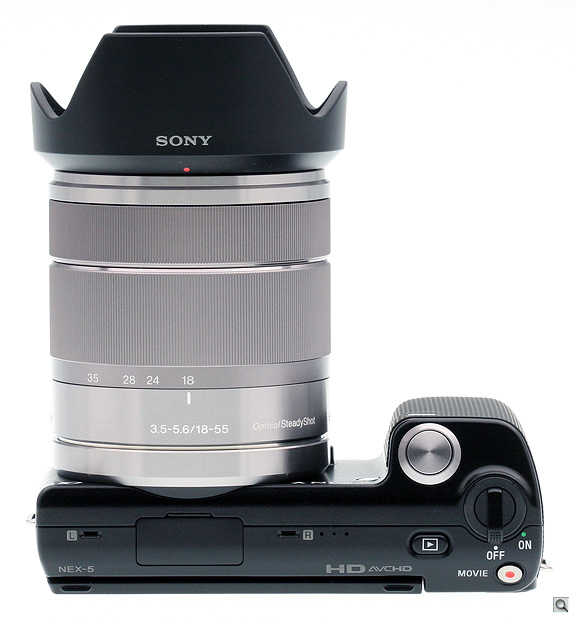
From the top of the Sony NEX-5 you see the stereo microphones, rather obviously marked L and R, and the three holes for the speaker. Between the two mics is the accessory flap, smaller than the one on the NEX-3, which you lift up and back, pivoting on its rubber hinge, to access the small accessory port. So far, the port accepts the included accessory flash and the optional accessory microphone; for now we haven’t heard of any plans for an accessory EVF, though Sony plans to release an optical viewfinder accessory with a 16mm field of view.
Here you can see the dramatic size of the 18-55mm compared to the camera body, made more dramatic by the included lens hood. The 16mm f/2.8 lens also has an aluminum barrel, and looks larger than it is, thanks to the metal mount, which is several millimeters thick. The lens is actually about as thick as the Olympus 17mm f/2.8 M.Zuiko pancake lens. The 16mm lens will also accept a wide-angle adapter and a fisheye adapter, which mount on the bayonet located on the inset plastic barrel that holds the actual lens elements.

Note the position of the two camera strap lugs on the Sony NEX-5. The Sony NEX cameras are designed to hang with the lens pointing down, just like their spiritual predecessors (the F505-F717 mentioned earlier). This has several advantages, one being that the screen is less likely to be scratched by shirt buttons, and the small camera body won’t pitch forward at different angles depending on what lens you have mounted. Sony knows that the lenses will usually tip the camera forward, especially on a camera whose body is so light, so why not just hang the lens downward in the first place? What I discovered when I attached the strap was that several of the camera’s design elements that seem awkward at first suddenly make perfect sense.
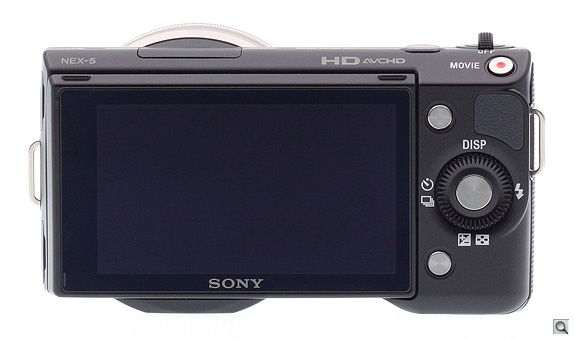
With the strap attached, the LCD is always facing up, ready for chimping. Wrap your fingers around the Sony NEX-5’s grip and bring your thumb around and up to the strap, and your thumb easily reaches the power switch. Draw your thumb back to use the Control wheel and soft keys. The Control wheel is very well designed, with a high edge around the perimeter with fairly sharp cuts for a good grip. Rather than fill the small space with expensive buttons, Sony has designed a new interface that’s context-sensitive.
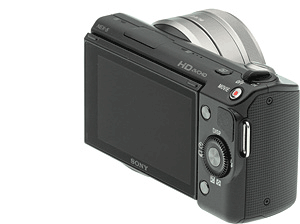
he Sony NEX-3 and NEX-5 have the company’s third generation Exmor sensor. It is an APS-C sized HD-CMOS sensor that Sony says is 60% larger than a Four Thirds sensor, and 13 times larger than a typical video camera sensor, so they expect performance gains in both areas.
he Sony NEX cameras have a dust abatement and removal system, where they’ve included a charge-protection coating on the low-pass filter, and they also vibrate the low pass filter to shake dust free.
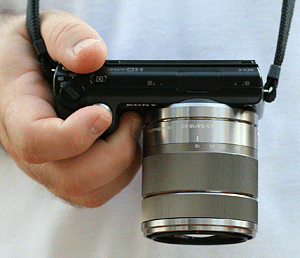
he Sony NEX-5 uses contrast-detect autofocus only. It has two autofocus modes AF-S for single and AF-C for continuous focusing. There are three autofocus area modes, including Center, Multi, and Flexible Area modes. You can also choose full Autofocus, DMF, which allows you to adjust focus after the autofocus operation, and Manual Focus. Focus is fast and fairly accurate. See the Shooter’s Report or Performance tab for more.
Sony’s new lenses are designed to respond more quickly than conventional SLR lenses can, with the express purpose of enabling autofocus while shooting video. Most SLRs either disable autofocus while capturing video, or else they essentially ruin the bit of the video where you’re focusing because of the lens motor noise and the excessive focus and exposure changes required.
an all-new lens system for the new NEX line, with a shorter flange distance (back-focus distance) to yield more compact lenses, and lenses with faster, more precise focus drive to meet the demands of live contrast-detect autofocus during video recording. The lens irises are also driven by stepper motors to provide continuous aperture adjustment to prevent sudden jumps in brightness as the aperture is adjusted while video is being recorded.
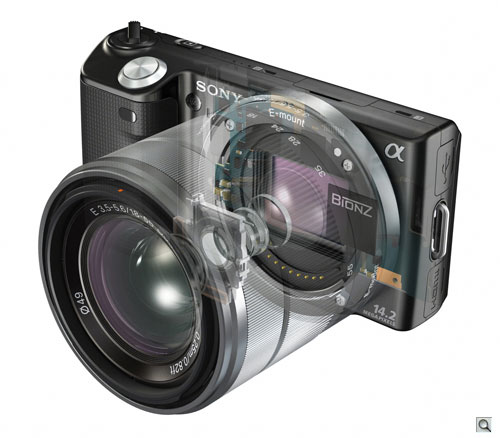
options include Auto, Daylight, Shade, Cloudy, Incandescent, Fluorescent, Flash, Color Temperature/Filter, and Custom.
Sony’s introducing a whole new menu system on the NEX series cameras, one that looks and sounds quite snappy as you navigate, but our pre-release cameras had a few problems that served as the only real negative points in our experience with the NEX-5 and NEX-3. See the Shooter’s Report for more on that. The general interface is pretty good, if you stick to the basic controls.
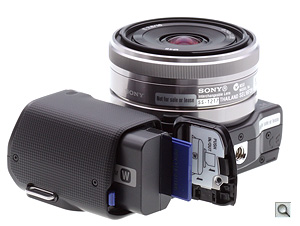
on Sony’s TX1 and WX1 digicams a year ago, the high-speed ability of the NEX-5’s advanced Exmor CMOS image sensor and the power of Sony’s Bionz processor lets you capture in-camera panoramas by simply holding down the shutter button and “sweeping” the camera across in a short arc. The result can be a panorama up to 12,416 pixels wide, covering a horizontal angle of 149 – 226 degrees. Or, sweep the camera vertically, for a narrower/thicker panorama up to 5,536 pixels wide, covering a vertical angle of 106 – 151 degrees. Sony’s high-speed technologies take SLD shooting into a whole new dimension. (And sometime in July of 2010, it’ll literally take you to a new dimension, when a firmware update will let you create panoramas in 3D, for display on Sony’s 3D HDTV sets.)
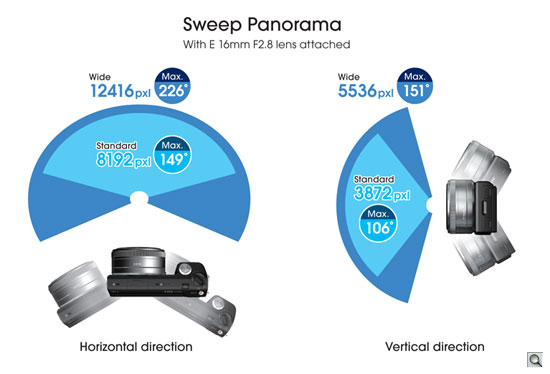
The Sony NEX-5 uses a 7.2V 1080mAh lithium-ion battery with part number NP-FW50. Tested to the CIPA standard, the Sony NEX-5 is expected to get about 330 shots per charge. Expected Battery life is shortened somewhat because while the camera is on and in Record mode, the Sony NEX-5 will continue to seek focus whether you’re in continuous or single focus mode.
To my surprise, I’m more drawn to the 18-55mm lens than to the 16mm. The opposite is true with the Micro Four Thirds camera, where the 17mm is pretty much all I use for the shooting I do. Since the 17mm is equivalent to a 34mm lens, it’s natural I’d prefer that over the 24mm equivalent found in the 16mm. Though I used to love my 24mm on my old film cameras, the way the lens distorts faces at the edges makes for unappealing family photos. The good news is that it really grabs the scene, great for landscapes. The bad news is that you have to step forward quite a bit more than you thought you would to fill the frame with your subject, and the result is often distorted, unnatural people pictures.
I like that they included the flash with the Sony NEX cameras, rather than made it an aftermarket purchase, as Olympus did with its first two Pens. I also like that you can take it off. It’s absolutely tiny, rests right above the lens, and jacks in via a special connector concealed beneath a plastic door. A thumbscrew tightens the flash in place, and on the NEX-5 at least, the flap marries neatly with the flash’s thumbscrew door. As I say, it rests flat above the lens, but must be flipped up to activate. The camera senses when it’s flipped up and fires in the selected mode.
A cool Scene mode called Handheld twilight (HHT) does a trick that some of Sony’s backlit-sensor cameras introduced last year. No, this sensor is not backlit, but it will fire off six shots at a hand-holdable shutter speed and combine them into one usable image that you’d never get without using a higher ISO.
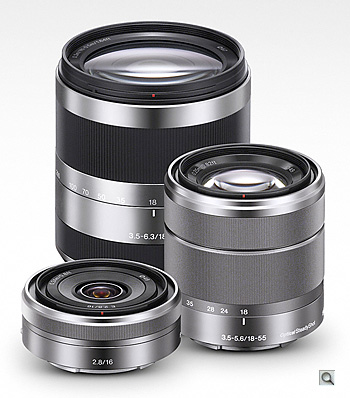
Another multi-shot mode designed to improve your images is the Sony NEX-5’s HDR mode. Dynamic Range Optimization does a little electronic processing to enhance shadows and maintain highlights, but when that’s not doing the trick, you can (after some fumbling in the menus) activate Auto-HDR. Again, this handy mode fires off three hand-holdable images that expose for the highlights, the mids, and the shadows and combine them into one image that has usable detail in all of these areas. Often, these images can look flat, because they essentially process out image contrast. The good news is that the Sony NEX-5 also saves a copy of the middle exposure before building the HDR image, giving it the next number in the series. While I’ve often been pleased with the HDR image onscreen, I was occasionally glad I had the regular exposure as well, since HDR can too often just look surreal. Not just from the NEX, by the way, but all HDR images.
Focus is active at all times, far as I could tell, whether I had continuous focus on or off. I usually choose the Center point AF option regardless what camera I use, but the Sony NEX-5 has a strange habit of just giving up and selecting the entire image as the center, especially in low light. I’m not really fond of that. I want to know that it’s going to focus where I tell it, so I switched to Flexible Spot, which has the added benefit of moving to just about anywhere onscreen, corner-to-corner, just missing the edges.
ut simply, bokeh is the quality of the out-of-focus areas in an image, and Sony boasted that their larger APS-C sensor (which allows a narrower depth-of-field) combined with their optics give better bokeh than Micro Four Thirds cameras can. It seems to be true of the two kit lenses, with background elements appearing a little softer and smoother from the Sony. The quality of bokeh can vary quite a bit, though, depending on which lens you use.
Of course, it’s not all great news. The Sony NEX-5 is a blend of more traditional digital camera design with an SLR sensor and interchangeable lenses, but the best of both worlds were not always chosen. In this case, Sony says they completely redesigned the interface to make it easier to control with only a few buttons, but it really brings to mind the inconvenience of some of Sony’s recent Cyber-shot menu systems. My first impression of the NEX-5’s menu system was quite positive, because it was snappy and beautiful. The most attractive item is the Scene menu, in fact, which includes high resolution photos to illustrate the purpose of each. Very nicely done. For the first time, too, the sound that accompanies menu selections — a sharp click — is actually quite nice. Unfortunately, my initially positive reaction to the NEX-5’s menus didn’t survive my actually trying to use them.
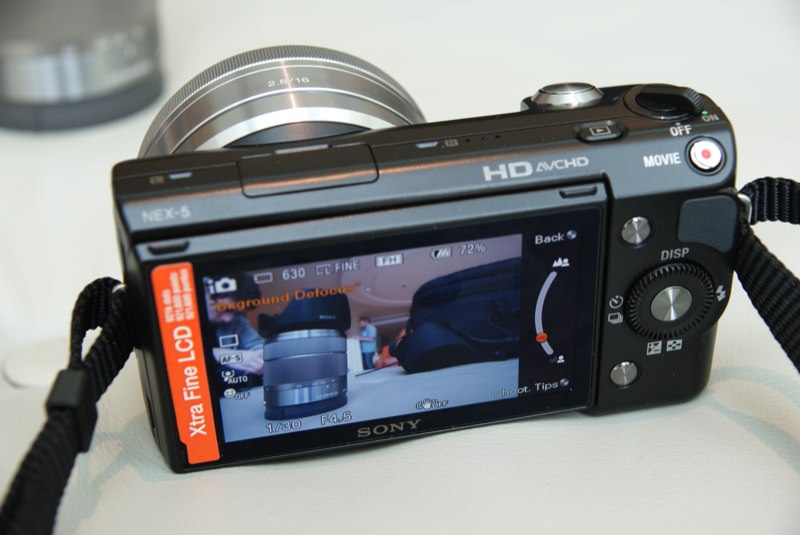
1.Make the system less modal; let the user change more things regardless of the mode the camera is in. For instance, rather than requiring that the user first set AF area to Multi and change the AF mode to Autofocus or DMF before they can select Face Detection, why not just make the choice of Face Detection put the camera in AF/Multi-Area mode? Telling the user that the Face Detection function is disabled isn’t at all helpful. And why shouldn’t users be able to select digital zoom with zoom lenses if they want to? Ditto panorama direction or panorama size, when they’re not in Panorama mode? Having items mysteriously greyed-out only makes the camera more confusing for users of any level.
2.If you can’t get rid of the modal nature of the menus, add explanatory text, telling why an option is greyed out, rather than just saying “This function is currently disabled.” – This would arguably hold more real end-user benefit than the current 80 pages of shooting tips.
3.In Playback mode, make the Menu button take you immediately to the Playback menu, and make the first option there be Still/Movie Select. (This is one place where the camera really needs one more button, as all the buttons on the back already have necessary functions assigned to them.)
4.Add a setup menu item that would let you configure the lower-right button as a custom function button, rather than defaulting to Shooting Tips. Let the user configure it to optionally control their choice of White Balance, ISO, AF area (it does currently turn into Focus when you’re in Flexible Spot mode, so you can adjust the focus point, but it’d be nice if you could choose to make it select AF mode all the time as an option), Face Detection, Metering Mode, DRO/HDR, Creative Style, and possibly Steadyshot.
5.Add a Quick Menu, optionally activated by the lower soft button, to give quick access to a number of common settings. (The list above would be a good start, but add things like image size/quality, movie type/size, etc as well.)
6.On future models, don’t be quite so focused on reducing the number of buttons. Even one more button in the lower right corner of the rear panel, or to the left of the Movie button on the angled top panel could have really helped with some of the user interface complexity.
JPEGs look very good printed straight from the Sony NEX-5. Enlargement of these 14.2-megapixel images to 20×30 was a tad soft from ISO 200, but better than most 12-megapixel cameras can do. Shots at this size would be fine for wall display, and would sharpen up nicely in a photo editing program. That softness becomes a non-issue at 16×24, though. Color saturation is great and contrast seems a bit high, but not unpleasant.
However, whether its design is a love it or loathe it affair, the NEX-5 really wins where it matters. Firstly its contrast-detection Quick AF Live View system is pretty much as good as they get. It’s not as advanced as a DSLR, yet it is miles beyond what a compact camera could offer. Secondly the image quality is exceptional, certainly class-leading when lined up against its competition and would hands-down give a lot of DSLR cameras a serious run for their money – even ISO 12,800 produces useable image quality.
Despite its occasional blips, Sony-only accessory fitting and an irksomely slow start up time, the NEX-5 otherwise feels fresh, new and exciting. When more E-mount lenses see the light of day this certainly looks to be a true winner.
Overall the NEX-5 has the image quality box well and truly checked.
Resources :pocket-lint.com,imaging-resource.com
Sony NEX-5 review

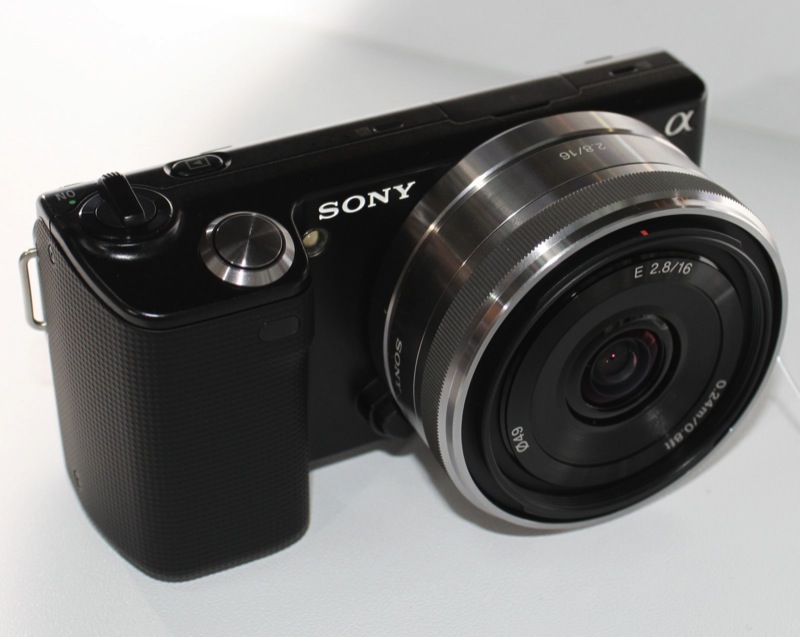
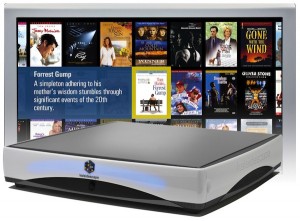
Pingback: Gadget Newz
Pingback: Tweets that mention Sony NEX-5 review | TheTechJournal.com -- Topsy.com
Pingback: Divers tests du Sony NEX-5
Pingback: 14″ CP Custom Products Tippmann 98 Paintball Barrel | Revolver Airsoft Guns
Pingback: Fugitive Dust Tracking Down And Controlling The Sources Along With Developing Solutions | EZ Southern Cooking - Blog
Pingback: best binoculars
Howdy, You publish some excellent blogs, I like nearly all of your article content. I always check back here often to find out in case you have updated. Carry on blogging!
With the introduction of NEX-5 , sony enters into the battle for market shares as desired. This is an exciting time in which it is likely that the status quo are gradually taking a different position.
With the introduction of NEX-5 , sony enters into the battle for market shares as desired. This is an exciting time in which it is likely that the status quo are gradually taking a different position.
SONY ALPHA NEX-5. Excellent pictures with the 18-55 model SEL 1855 lens. 3meg minimum resolution is ok for casual shooting. BUT the camera is not well backed up by Sony yet. It is too new. I lost my flash on the first day I received it, October 2nd, 2010, and to this date October 22, Sony cannot provide this flash through any of its outlets, SonyStyle, Sony Parts, or dealers. More so, there are no compatible flash units in the market. So, if you need a larger flash, forget it. It is shameful that Sony can put such a fine camera in the market without proper backup. I would NOT recommend purchasing this camera until full back up is available through Sony or through dealers
Pingback: Private Servers
Thanks for this information, very elaborate and useful stuff. I’ve just got this camera and happy.
For all those who’re still thinking of buying it I would say go ahead, worth the price. Sony India is also giving 4 GB memory card free with this camera and they also have a contest right now. If interested you can participate here – http://www.flickr.com/groups/sonyindianex5
I’ve added my pics and hope I win.
There are a lot of functions “disabled” on my new sony nex-5, including the “creative style” function which allows you to shoot black and white photos. How do I enable these?
I’m having troubles with my sony nex 5!!! everytime i’m gonna take a shoot, the camera works properly (focus, move zoom) but by the time i press the button to take the photo it won’t work!!!! i tryed changing the camera modes, changing the lenses and nothing works,,, i think it might be the button because i do videos with no problems!! any idea of what’s going on??